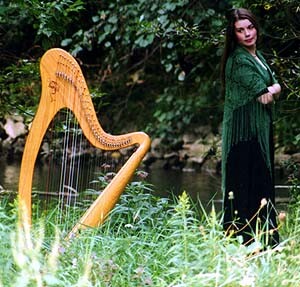 In general, harp recordings can capture a good bit of the enchantment of the instrument, but rarely do they come close to the magic of hearing a live harp performance. Jennifer White’s Clarsach sounds more like sitting in someone’s living room listening to them play harp live than any other I have experienced. The sounds are bright and inviting, hauntingly vibrant, alive. You can hear the physical sound of the fingers on the strings, and it all sounds completely natural. This is a spectacular feat, for it can be quite difficult to find the right arrangement of microphones to get just the right amount of the physical sound from the harp without it becoming overwhelming or distracting. The balance between bass and treble is also perfect.
In general, harp recordings can capture a good bit of the enchantment of the instrument, but rarely do they come close to the magic of hearing a live harp performance. Jennifer White’s Clarsach sounds more like sitting in someone’s living room listening to them play harp live than any other I have experienced. The sounds are bright and inviting, hauntingly vibrant, alive. You can hear the physical sound of the fingers on the strings, and it all sounds completely natural. This is a spectacular feat, for it can be quite difficult to find the right arrangement of microphones to get just the right amount of the physical sound from the harp without it becoming overwhelming or distracting. The balance between bass and treble is also perfect.
After recovering from the shock of the outstanding recording process, I was pleased to note that the playing is equally remarkable. Crisp, clear notes, passionate performances, and a marked dynamic range bring out Jennifer White’s virtuoso finger dancing. Six of the tracks are solo harp, while the other tracks make use of White’s vocals and penny whistle, or guest artists on instruments such as doumbek and percussion (Robert McMaster); chimes, guitar, and bass (Ben White); and fiddle (Darrin Schott.)
Particularly enjoyable are the traditional tunes. White’s rendition of “Sheebeg & Sheemor” is striking, emphasizing specific phrases with slightly unusual timing and a strong flowing quality to the music. “The Rights of Man” combines the upbeat harp with a strong percussion cadence. This gives it the feel of the revolutionary uprising Thomas Paine meant to encourage on the publication of his thesis by this name. The addition of penny whistle to the track adds the final touch to the vision of fife and drum corps. The only true song (rather than instrumental) on the recording, “Loch Lomond,” is a lush, introspective closing to the recording. White’s harp bubbles like a brook behind her soaring vocals, while the use of harmony vocals gives the whole song a mystical quality.
The rest of the recording consists of nine of White’s original compositions. Most of these rise out of folk tales or legends. There is the tale of Oisin, who went to live with the faerie folk for seven years, and when he returned found 300 years had passed. There is “The Selkie’s Dream,” drawing upon selkie themes from many tales. “The Legend of Knockgrafton” explores T. Crofton Croker’s tale about a hump-backed man who receives assistance from the faeries for his kindness. Each tune beautifully captures the spirit of these traditional tales or themes, using thematic harp sequences, sounds of nature, and sometimes wordless vocals to illustrate these familiar stories.
Also drawing on personal experience, White creates a number of tone poems, capturing the feel and essence of tiny vignettes of everyday life. My favorite of her original tunes is “A Jig for the Autumn Wind,” which wraps the listener in swirls of wet, falling leaves on an inviting, brisk day in autumn. You can feel the updrafts and growing chill as the music progresses, but you feel safe and warm inside your warm autumn clothing.
Although White’s original music is generally not melodically strong enough to leave you humming the tune, the lush, illustrative quality of her music creates a strong sense of place for her listeners, leading them to a faerie world from which they are likely to desire not to return. The overall mood and flow of the recording would make it an excellent soundtrack for a fantasy movie. If you enjoy dreamy, evocative harp music, don’t miss Jennifer White’s Clarsach.
(Knockgrafton Productions, 1998)
